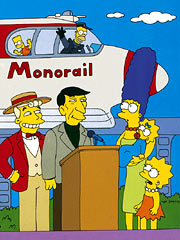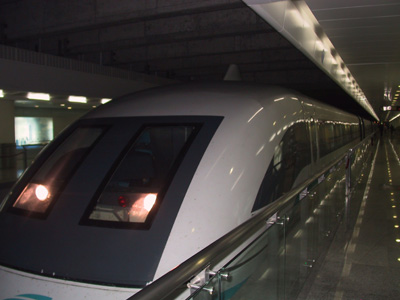In the future we will all levitate to work
I had a chance to ride the world’s only operational magnetic levitation train this week in Shanghai. It was the highlight of an otherwise awful layover. The train itself runs from Pudong airport to the terminus of one of the city subway lines (not exactly downtown Shanghai). There’s some debate about how useful this is to actual travelers, but as a way of killing time it was perfect for me. I purchased a roundtrip ticket.
Actually I purchased a VIP ticket. (They love the designation VIP here. You see it everywhere on special doors, stairways, and parking spaces.) I thought, if I’m going to ride a space-age train I am certainly going to do it in first class. In a future of jet packs, flying cars, and supertrains we’ll all be VIP’s anyway so I better get practicing. The cost difference was $2. The actual difference? Slightly nicer seats and a completely empty car cabin.

There’s a brief shudder as the train shimmies up the half-inch that the magnets levitate it above the track. Then off you go, mostly silently. Since the means of propulsion and power are embedded in the track (the magnets pull you along as well as prop you up) there’s no loud onboard engine. You accelerate quickly. Not unlike an airplane takeoff without the din. Just a few minutes in you’re moving at 430 km/h (270 mph) and you can feel it. The slightest jostle (and it has to be slighter than the half-inch tolerance of the magnetic “cushion”) and the train responds. You could not, for instance, play Jenga successfully on board. Still it is damn smooth for going 270 mph.

But you do wonder what would happen in the event of catastrophe. On an airplane there’s room for error, approximately 30,000 feet of room for error; you can recover. On a train moving at this speed if you depart the track you’re basically done. What happens if someone dumps a large chunk of metal on the track? Or a mini-cyclone blows the train over? Or a power spike into the track torus? (There actually was a fire onboard recently.) All thoughts that have nicely counteracted my recent preoccupation with air disasters.
On the return leg I was in the front car (again alone, the sole VIP of a future society). I staggered to the conductor’s cabin as we hit max speed. Peering in I saw exactly what I expected — computer screens and a panel of buttons — and something I did not — the conductor lounging at the desk reading the newspaper. She’s likely there for show only. Or a robot. In the future, trains are conducted by robots, as you probably know.
As you pass a maglev going the other direction there’s a super-brief concussive moment where too much air is being displaced from too little space. It makes you jump. Unfortunately the eight minute journey is almost half acceleration/deceleration. When you arrive at the destination station and disembark you’re greeted by a strong burning smell. I can only guess it is a byproduct of the magnetism since nothing should be ablated during the journey. Nothing touches anything. This is the future, damnit.

The maglev, officially known as the Shanghai Transrapid, is usually called a demonstration line. It doesn’t go anywhere very useful right now, though there are many ideas for expansion, especially in advance of the 2010 Shanghai World Expo. The whole experience, while fascinating and exciting, was a bit depressing. With the small ridership (all in non-VIP class) it all felt like a bit of a show. Sort of like the futuristic people mover underneath the Huangpu River. Fun to take, but how practical? A Disney monorail without the Disney crowds (or high ticket price to offset the cost of running such a novelty).
The future’s always a novelty to the present though, isn’t it?
The full image set is available.















Apologies for fueling your new crash obsession but this is what happens in the event of a maglev accidentJohn – Mag-lev crash kills 23
That said we took the Shanghai maglev to the airport last Summer, a great way to finish off the trip.
Perhaps the burning smell was that of ozone produced by the strong electromagnetic fields on the guideway.